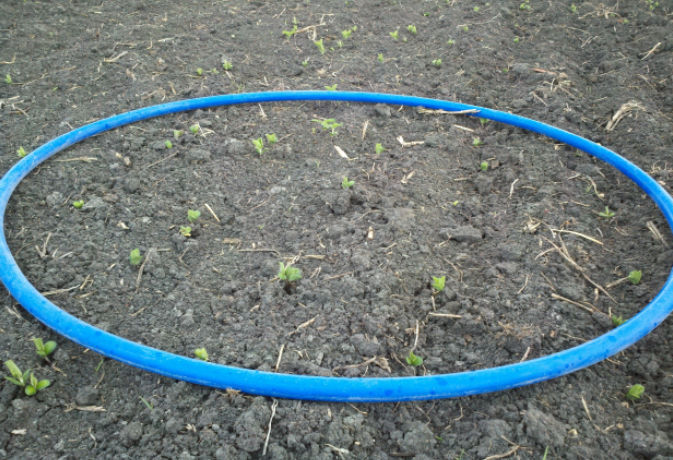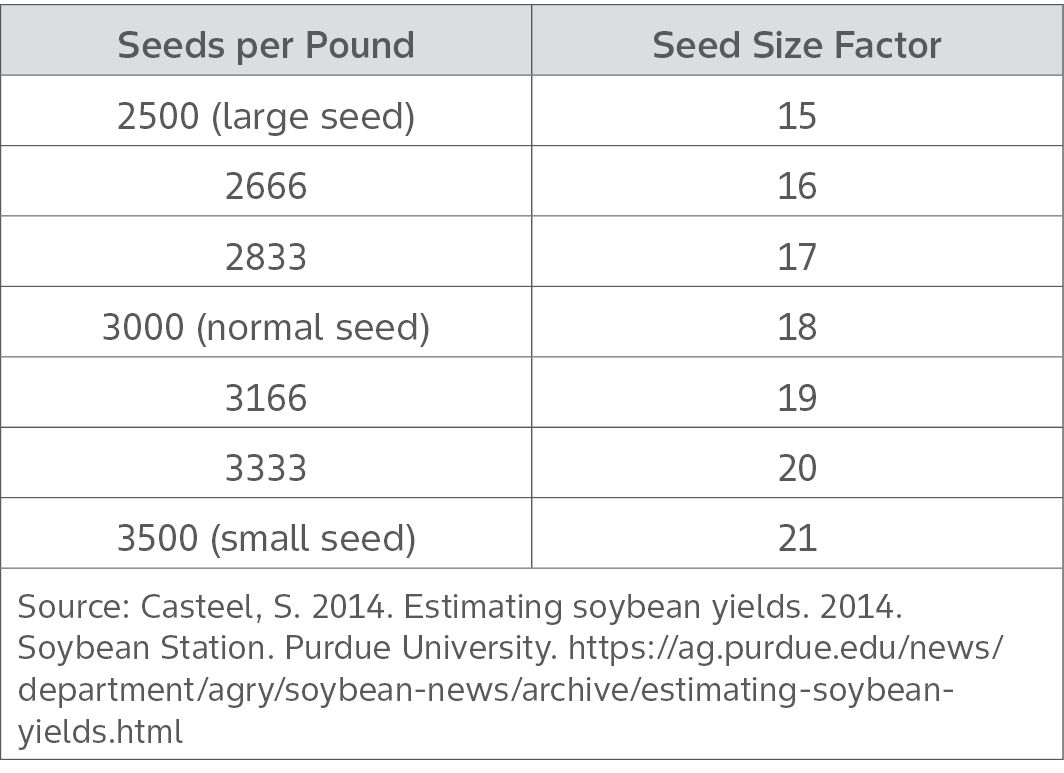3 MIN READ
Estimating Soybean Yield Potential
June 5, 2025
- Estimating soybean yield potential can help formulate storage, drying, and marketing decisions.
- During the yield estimation, scouting for weeds, insects, diseases, and wildlife damage can be accomplished.
- Weather related issues such as drainage and hail damage can be identified during the estimation.
Value of Yield Potential Estimation
Estimating yield potential can provide valuable information that can help to formulate decisions regarding storage, drying costs, and marketing. In addition, while gathering yield potential information, the field can be inspected for weeds, insect activity, disease incidence, and any wildlife injury. Evidence of water, hail, and other environmental issues also can be found. As an example, loss of plant population due to ponding could help formulate plans to mitigate drainage issues.
Potential yield estimates for a soybean crop can be determined at the R5 growth stage, but estimates made at the R6 growth stage (maturity) or later are usually more accurate. There is a conventional approach and a simplified approach to calculating an estimated soybean yield. The conventional method uses the total plants/acre in the calculation while the simplified method uses a constant row length that represents 1/10,000th of an acre. In general, the approaches determine yield estimation through measurements, counting, and set values. The components include:
- Number of plants/acre
- Number of pods/plant and pods/acre
- Number of seeds/pod
- Number of seeds/pound
- Total pounds/bushel, or test weight (60 lb/bu)
Conventional Method for Determining Number of Plants per Acre
This plants/acre estimation method depends on if the field was planted with a row planter or a drill. Counting the number of plants per length of row can be used if the soybean crop was planted with a row planter. The number of plants per unit area within a hoop is used if the field was drill planted. Because of plant size, it is easier to take the counts after emergence and save the results for later in the season for estimations.
For row planting, the 1/1000th acre method helps determine plants/acre by counting the number of plants in 1/1000th of an acre at several random locations (Table 1) and multiplying that number by 1000. For drill planting, the hoop method involves determining the diameter of a hoop, tossing it randomly in the field, and counting the number of plants inside the hoop (Figure 1). Multiply the number of plants within the hoop by the appropriate factor in Table 2 to determine plants/acre. If making a hoop, an appropriate diameter is 28.25 inches, which allows for multiplying by 10,000.1 The hoop can be made by cutting a tube, such as anhydrous tubing, to a length of 88.75 inches and adjoining the ends. Regardless of method, several counts should be obtained at random locations across the field to estimate a final plant/acre average. Unless the population has been dramatically reduced during the growing season by an environmental event, the early season populations can be used for harvest-time yield estimations.
Table 1. Length of row needed to measure 1/1000th of an acre for various row widths.


Table 2. Plant count evaluation factors, by inside hoop diameter, for determining soybean plant populations.

Simplified Method for Determining Number of Plants per Acre
The simplified method for determining plants/acre uses a constant measurement of 21 inches (53.34 cm) of row length which is equal to 1/10,000th of an acre. Multiply the number of plants in the measured area by 10,000. The method is more reliable if 8 or more plants (80,000 plants/acre) are in the sample area. If plants/acre is 7 or less, more sampling areas should be used to have a better population representation.2,3 The number of rows to measure depends on row spacing:
- 30-inch rows, count the plants within 21 inches in one row
- 15-inch rows, count the plants within 21 inches in two rows
- 7.5-inch rows, count the plants within 21 inches in four rows
- For other row widths, divide 627.26 by the row width to calculate the length of 1/10,000th acre. An 18-inch wide row would require the measurement of 34.8 inches for one row instead of 21 inches.
Determining Pods Per Plant, Average Seeds Per Pod, and Pods per Acre
Conventional Method: The average number of pods/plant can be obtained by counting the number of pods with at least one seed on 10 consecutive plants (don’t skip small plants) at the locations where the measurement for plants/acre were determined.1 Divide the number of pods by 10 to get the average pod count. The average seeds/pod can be calculated by selecting 10 random pods, from the 10 plants, and counting the seeds in each. Dividing the total number of seeds by 10 provides the average seeds/pod count for that location. Healthy plants can average about 2.5 seeds/pod while those under stress are likely to have 1 to 1.5 seeds/pod.1
The seeds/lb calculation can be challenging. A value of 2,500 seeds/lb is indicative of a healthy plant.1 Stressed soybean plants may have closer to 3,500 seeds/lb which should be used in the formula for estimating potential yield. The weight of a standard bushel of soybean weighs 60 lb which should be used in the conventional calculation formula.
The Simplified Method for seeds/lb uses constant factors for estimated yield potential (Table 3). If growing conditions have been favorable and larger seeds are present, a seed size conversion factor of 15 units may be used. If growing conditions have been unfavorable, a seed size factor of 21 units may be used.2,3 The calculation can be changed throughout the remainder of the growing season as growing season conditions are likely to change after initial measurements and calculations have been made.2,3
Table 3. Simplified Method seed size factors based on estimated seeds per pound for calculating estimated soybean yield potential.

After determining the different factors required for the two methods, potential yield estimation calculations can be made using the formulas for each method.
Conventional Method: ((plants/acre x pods/plant x seeds/pod) ÷ seeds/lb)) ÷ lb/bu = Estimated Average Yield (Bushels/Acre).
- Example: ((134,000 plants/acre x 24 pods/plant x 2.8 seeds/pod) ÷ 2,500 seeds/lb) ÷ 60 lb/bu = 60 estimated bu/acre average for a sampled location
Simplified Method: Pods x Seeds per Pod ÷ Seed Size Factor = Estimated Average Yield (Bushels/Acre).
- Example: 300 pods x 2.8 seeds/pod ÷ 17 = 49.1 estimated bu/acre average for a sampled location
Adding the average yields from each sampled location and dividing by the number of locations provides the overall estimated average yield potential/acre for the entire field.
Sources
1Frankenfield, A., Curtis, Z., and Lingenfelter, D. 2024. Assessing corn and soybean populations and replanting decisions. PennState Extension. College of Agricultural Sciences. The Pennsylvania State University. https://extension.psu.edu/assessing-corn-and-soybean-populations-and-replanting-decisions
2Ciampitti, I. 2014. Estimating soybean yield potential: There is a web-based app for this also! Agronomy eUpdates. Kansas State University. https://eupdate.agronomy.ksu.edu/article_new/estimating-soybean-yield-potential-there-is-a-web-based-app-for-this-also-470-2
3Casteel, S. 2014. Estimating soybean yields. 2014. Soybean Station. Purdue University. https://ag.purdue.edu/news/department/agry/soybean-news/archive/estimating-soybean-yields.html
Corn & Soybean Field Guide. ID-179. Purdue Extension Publication. Purdue University.
Web sources verified 5/1/25. 1314_60011